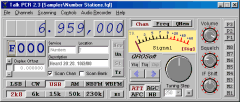|

HOME
Radio Books

UK
Source
US
Source
|
 |
To keep the receiver ON while unattended
Ted's tip followed a request as how to keep the radio on, with no cable or
PC connected,
"It is necessary to pull the DTR
(pin 4) and RTS (pin 7) lines high on the RS-232 Serial port. This can be a
little tricky if it's necessary to unplug the serial cable. A breakout box
with the proper connections installed between the receiver and serial cable
should work; just don't unplug the breakout box.
It isn't be necessary to send periodic commands to the receiver. The
receiver definitely 'goes to sleep' after 20 seconds if the serial cable is
removed.
Icom doesn't use this feature, but you can force a remote reset of the
receiver by pulling the DTR/RTS lines low and holding for 20 seconds, or so.
This seems to work just as well as turning the front panel power switch off
and back on. Perhaps the software developers on the list can incorporate
this feature in their next releases."
Ted, WB5REA
Wideband Discriminator Output
This may be old news for some people, but what the heck.
I was flipping through the PCR-1000 service manual, and noticed that the
wideband FM discriminator output is available on the DSP connector. I
haven't modified mine yet (other priority projects in the queue!), but
I think I'm going to add a 3.5mm stereo jack somewhere in the housing,
and put the NBFM discriminator output on one channel and the WFM discriminator
output on the other. Since mine is connected to a soundcard, this would
allow selecting whichever discriminator you like as input into programs
such as ACARS, satellite demodulators, etc. My main reason for all this
is to hook up my SCA decoder. The signal is available on pin 11 of J12,
which is one of the connectors where the optional DSP unit connects to.
This is straight off the detector chip (TA31136), so you might want to
consider running it through an op-amp circuit with some settable gain,
and make sure the input impedance is something the chip will be happy
with. I haven't looked up the part yet, but when I get around to this,
I'll post a schematic on my website. -- Chris,
jcwren@jcwren.comon the PCR Mailing List. Thanks Chris!
DGPS / MSK
Peter Andersson's setup
to decode the Differential corrections transmissions for the Global Positioning
System (DGPS) that are transmitted using MSK.
LF Reception
From Larry VA3LK, I have been experimenting with the PCR
down in the area of 100 to 200 kHz. The radio works down here, it is not
as sensitive as one would like, in fact it is not very good at all but
it does work. Some issue for those who might be thinking of using the
radio down this low. First, put a 52 ohm resistor on the BNC jack and
sweep the range of frequencies you are interested in and make a note of
the spruious signals that are all over the place in this area of the band.
This will help you sort out the real and imaginary signals when you put
an antenna on the radio. When you put an antenna on the radio, I use USB,
Narrow, and put a modern spectrum analyser on the audio output. I happen
to use Gram. This will let you see signals you can not hear in the audio.
I was able to find several FSK teletype signals that I could not hear
as well as several I could hear very well. The big thing was to figure
out what are real signals as well as spurious signals inside the radio.
Not a great radio down at this frequency but better than nothing and good
enough to tune up a loop antenna and a preamp as well as a couple of filter
sections. Good Luck
Larry adds, I now have a tuned loop which is very narrow
band, only 1.5 to 2 kHz wide at the 3 dB points and this radio works very
well with that front end selectivity.
|
![]()
 A
selection of useful snippets
A
selection of useful snippets